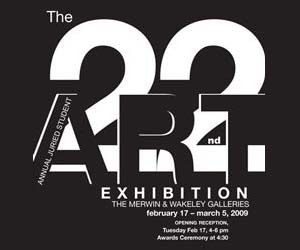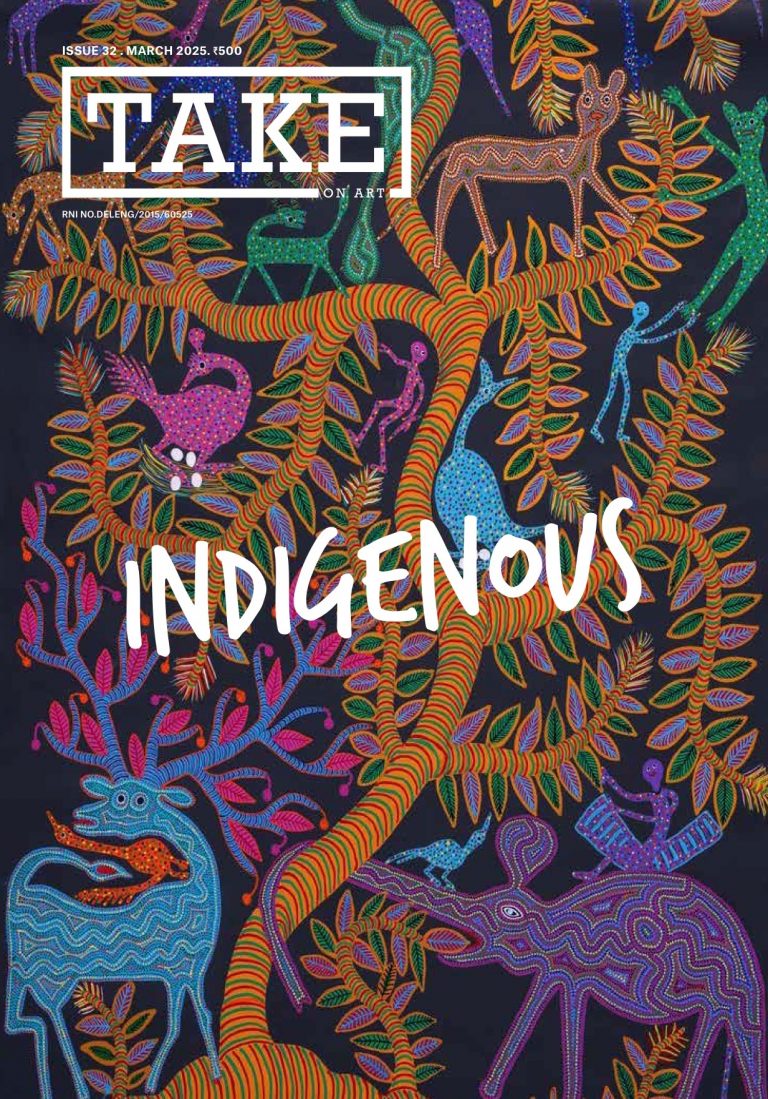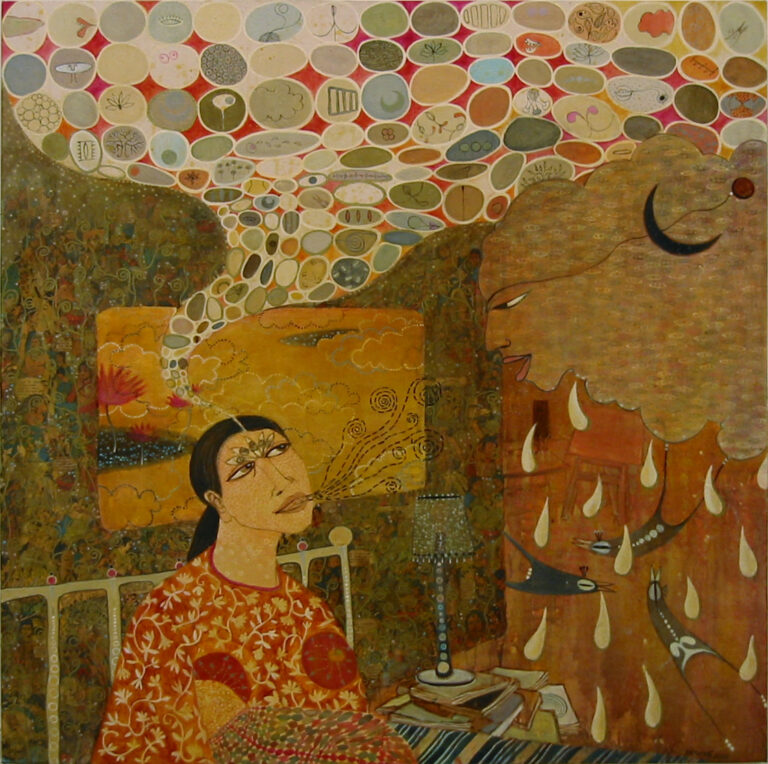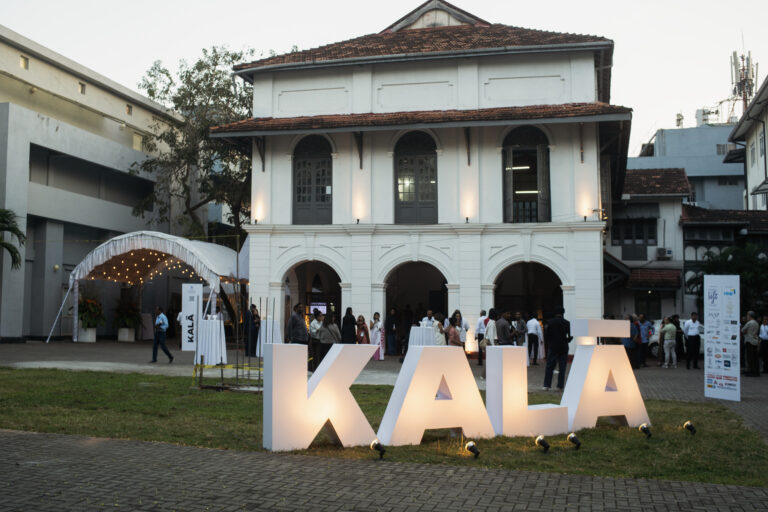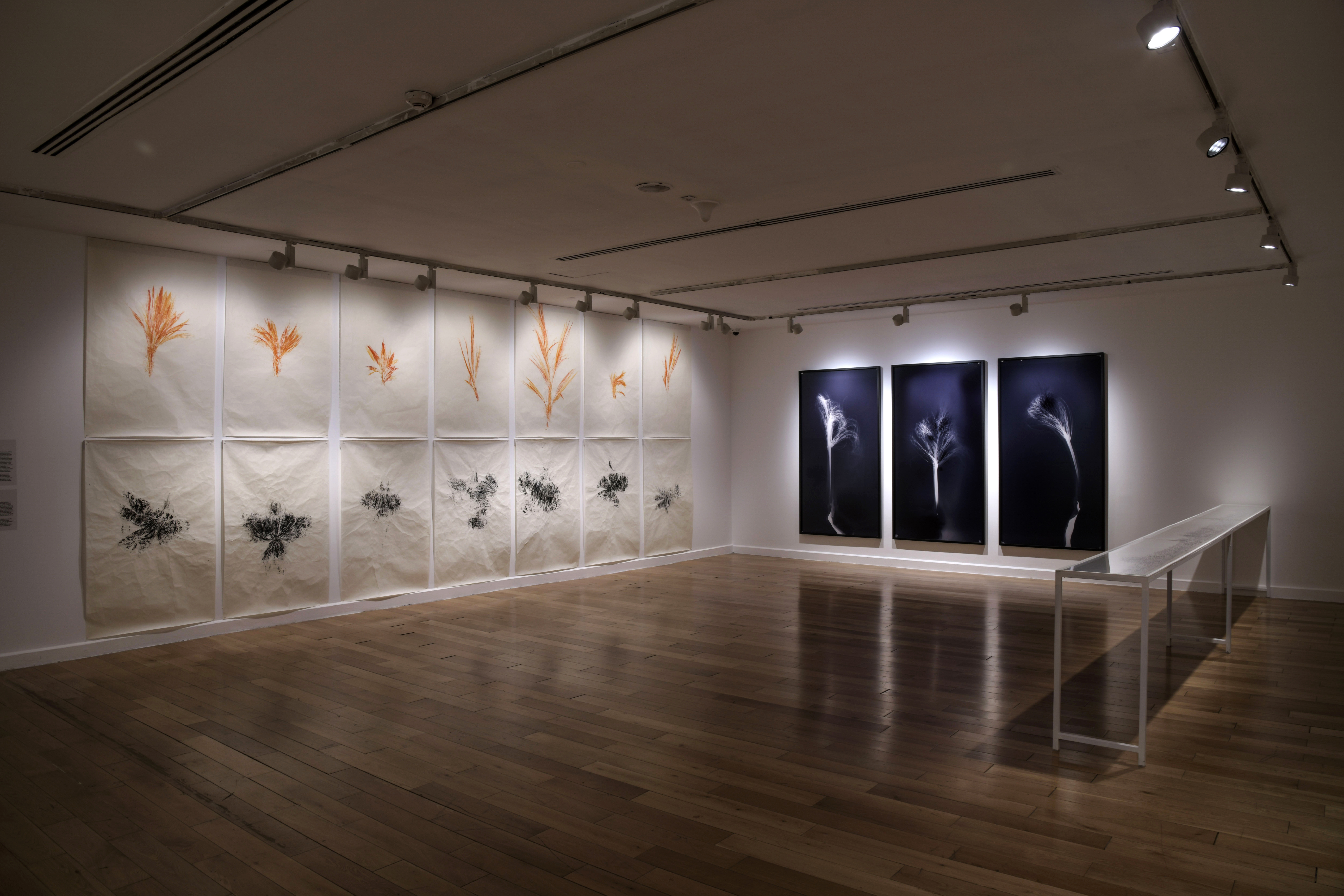
Left to Right: Simryn Gill, Travelling Light, 2017, Ink on paper, unqiue relief prints, courtesy of the artist and Jhaveri Contemporary; Simryn Gill, Clearing, 2020, Photogram, collection KNMA. Image Credit: Ashish Dhir. Image Courtesy: KNMA.
The most attractive aspect of contemporary art is its lack of geography, a pronounced absence of locational definition that can pinpoint it to a particular place on the globe. So, if one did not know the name of the artist, it would be very difficult to judge the work on the basis of its origins.
But why must we judge, after all? Should not art be consumed for the sake of it? Of course, yes! But it is only human nature to try and get to the bottom of things, so to speak… to dig deeper than what meets the eye, to go to the origin of stories that the artist tries to convey through his/ her/ their work.
It was with such a variety of thoughts in my head, jostling for my focused attention, that I entered the Kiran Nadar Museum of Art in Saket, New Delhi, to take a walk-through of the exhibition, ‘The Elemental You’. Not being too familiar with the works of the three artists on display—Hajra Waheed, Neha Choksi and Simryn Gill—proved a blessing as I was able to approach the show with a comparatively clean slate. The two things binding the three artists were that all of them are South Asian diaspora artists and each has pushed the envelope for contemporary art through her practice. The similarities ended there.
What the eyes were feasted to were actually three solo shows presented as one. Said the exhibition curator Akansha Rastogi: “Yes, actually, this exhibition could easily have been three solo shows. The body of work put together is huge. You get to see the depth and breadth of their works, their long-term commitments; all three of them have these lifelong projects, which we have presented here. All three are artists that I have been hugely in awe of and, when you see these works together, you realise that these trajectories, though independent, intersect at some point. But that is it; you forget about their commonalities after that point.”
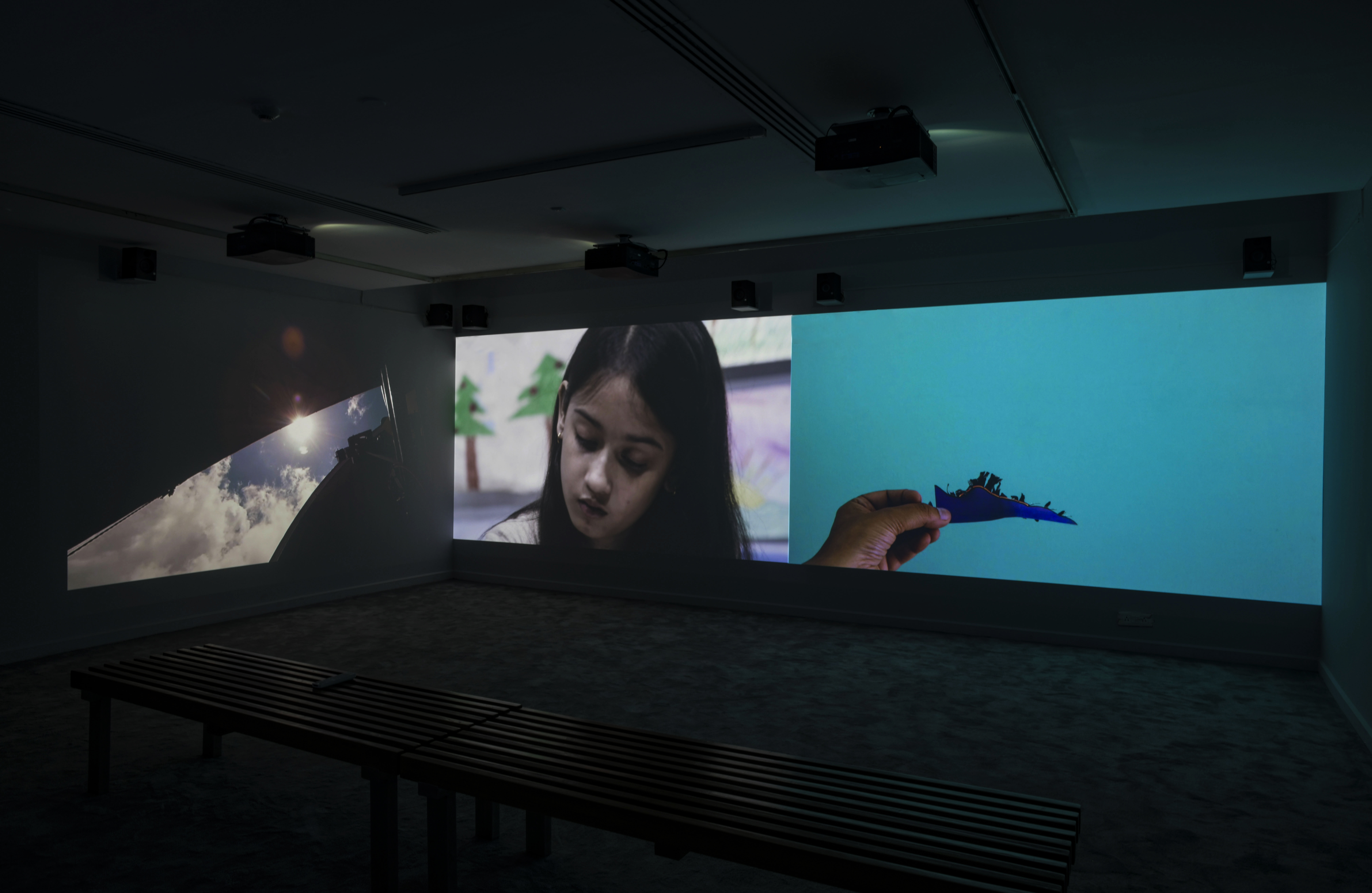
Neha Choksi, Everything Sunbright, Video installation, 2018. Image Credit: Ashish Dhir. Image Courtesy: KNMA.
Each of the artists explores the element ‘Earth’ as a geological, cultural or material experience, examining their own position in the world through the organic processes on the earth, and contextualising it all to make a political statement sometimes. Rastogi shared that, for decades, the three artists have engaged with rocks, stones, sand, plants, trees, fruits, light, animals and other beings as subjects and materials for their work, focussing on their multifaceted relationship with the natural world.
Therefore, a picture of the blue sky by Hajra Waheed becomes a metaphor for freedom and longing, especially for somebody whose life has been confined due to political and other phenomena beyond the individual’s control.
Her 2019 work, How long does it take moonlight to reach us? Just over one second. And sunlight? Eight minutes., is as simple as it is powerful in the message it conveys. Featuring sunned paper with a type-written note, this work was created in the artist’s studio as a tribute to her drawing practice, as well as a meditation on the energy of the sun and its importance. Through this simple work, Waheed wants to remind, and be reminded, of the sun’s energy, which provides us with life, and calls for living it patiently and in harmony with nature.
Montreal-based Waheed’s multidisciplinary practice ranges from painting and drawing to video, sound, sculpture and installation. At the core of her practice lies an attempt to explore the nexus between security, surveillance and the covert networks of power that structure lives, and she uses the ordinary to convey the profound, as evident from the two examples quoted above.
Singapore-born Simryn Gill, on the other hand, makes a more direct, and evident, comment on the impact of colonialism on the tropical islands of the world. Through photographs featuring human beings wearing canopies of luscious tropical fruits and other vegetation, Gill draws in the viewer strongly and immediately. The quirk in the photographs soon gives way to the artist’s political statement, which is self-explanatory. All photographs feature tropical places, and the fruits and vegetables strongly hint at how colonial rulers exploited the natural wealth of the colonies for their own good, without paying even an iota of attention to the welfare of the colonised. That is a story with strong resonance in India but Gill’s success lies in the strength of her engagement with the audience.

Hajra Waheed, Strata 1-24, 2017, Cut letratone and mylar, ink and archival tape on paper, courtesy of the artist. Image Credit: Ashish Dhir. Image Courtesy: KNMA.
Said Rastogi, “Gill, who is based in Port Dickson (Malaysia) and Sydney, has been documenting the people of the former for a long time. This is her lifelong project. Her politics is about the tropics and the colonial, and the ways in which lands are conquered.”
Neha Choksi’s engagement with the elements of the earth is more unmediated and head-on, quite literally. At the entrance, one is greeted by a video and sheer fabric curtain, which show the artist grappling with a huge rock. It’s a work from 2016, titled Dust to Mountain. But it is a work in the interior, which juxtaposes a fragile glass rod with sturdy and seemingly unbreakable rocks that hits the viewer hard, as if turning upside down the very perspective of permanence and impermanence. This multi-part sculptural installation in seven units, titled Porous Earth, 2023-24, features stones drilled out of rocks, air bubbles trapped inside glass, crushed stone poured through glass and miming a river, chisels held by stone, orbs and lenses that peer through the universe and other depths, a stone hinging its weight at the top of a glass sheet as it slowly sinks downward. This is a thought-provoking installation that helps the viewer question the very ideals they have inherited in their collective, universal DNAs. Using only stone, glass, and air, Los Angeles- and Mumbai-based Choksi goes to the very elemental part of the earth element.
I was especially struck by the river of crushed stone flowing down a glass pane, and the glass rod with bubbles trapped inside, piercing through two different rocks.
A special feature of the show were the profound texts that accompanied some of the works. That was another point of convergence for the three participating artists—all of them are remarkable writers, in the words of the curator, who has not shied away from sharing their creative output in the written form as well.
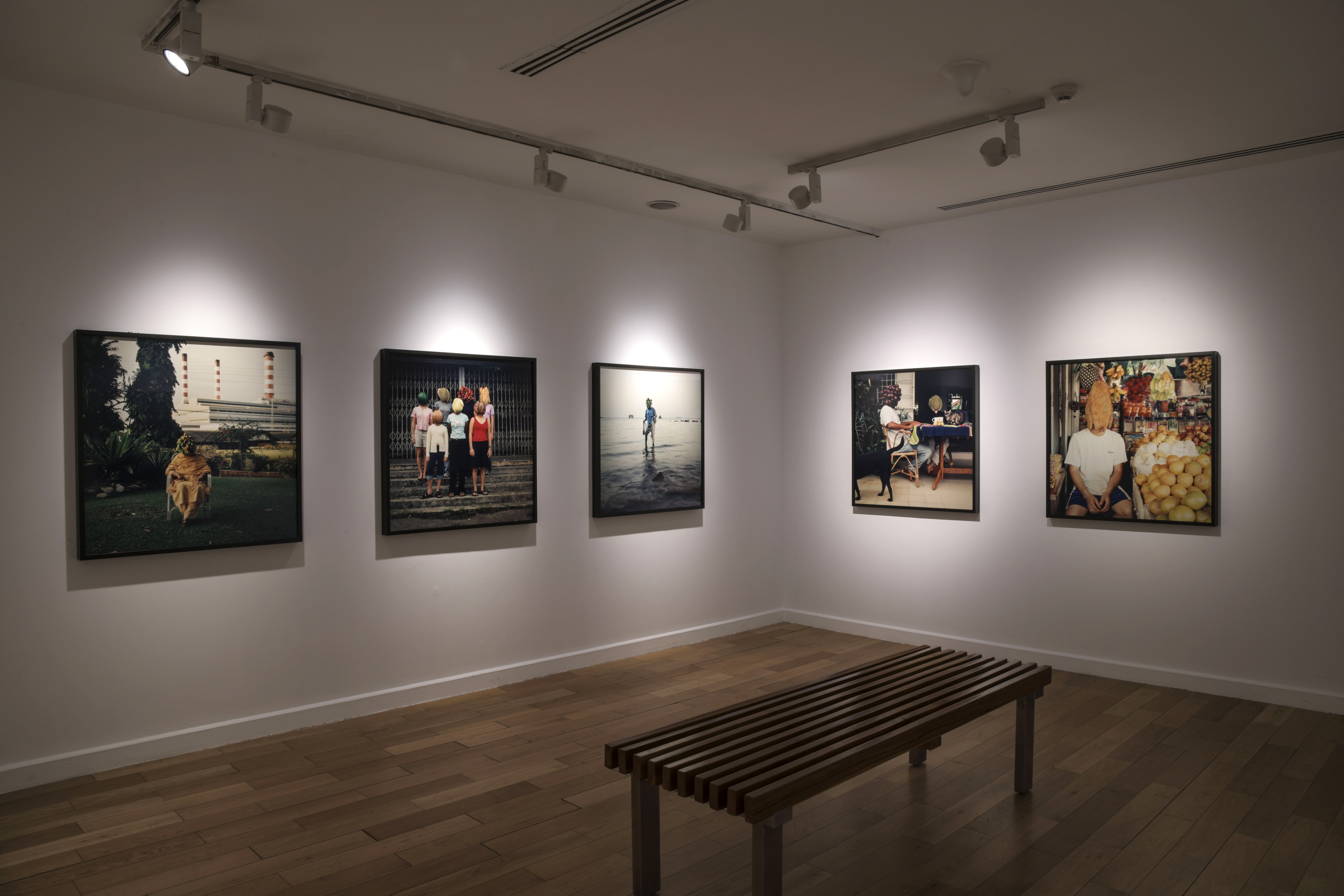
Simryn Gill, A Small Town at the Turn of the Century, 2001, C-print. Image Credit: Ashish Dhir. Image Courtesy: KNMA.
The show pushed the boundary of viewing art through our traditionally calibrated lenses and, in doing so, put KNMA in a different league of nurturing Indian art (needless to say, it is already in a different league altogether). With an overwhelming majority of Indians consuming and creating art through conventional tropes, shows such as ‘The Elemental You’ awaken us to the limitless possibilities that we ignore for the sake of convenience.
As I exited the museum after spending an interminable time at the exhibition—which was deliberately designed to be slow-paced—I felt layers developing in my own ways of looking at the elements of earth—soil, rocks, stones, skies and even the fruits and other crops humans cultivate for survival. Art, through this exhibition, seemed to have delivered its purpose.
The Elemental You, 15 October 2024- 9 January 2025, Kiran Nadar Museum of Art, New Delhi.










